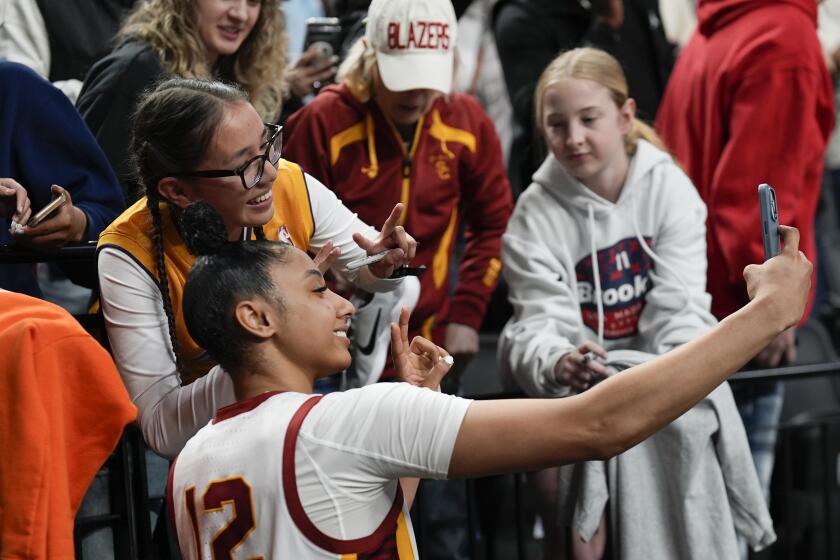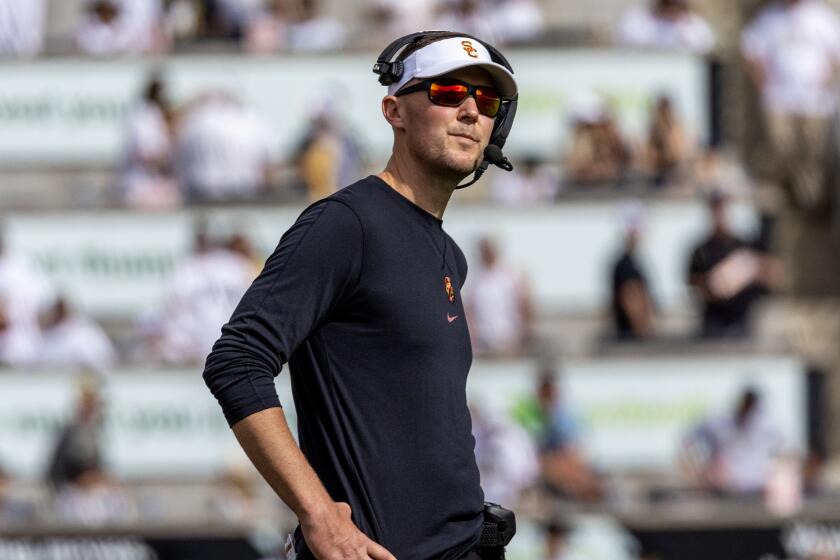A Year of Living Dangerously
Seventeen years.
The last time USC and UCLA played with so much at stake -- both teams highly ranked, only one loss between them -- was almost two decades ago.
The cross-town showdown between the No. 1 Trojans and No. 11 Bruins at the sold-out Coliseum on Saturday is special if only because it took so long to get back to this point.
Both programs had to rebuild since 1988, when second-ranked USC defeated sixth-ranked UCLA at the Rose Bowl. And they had to survive this season.
For USC, now one victory away from locking up a place in the BCS championship game, the margin of error was barely an arm’s length, Matt Leinart twisting across the goal line at Notre Dame. And where might UCLA be without Brandon Breazell scoring in overtime at Stanford or Marcus Cassel reaching to knock the ball loose against Arizona State?
“It’s hard to keep winning,” USC Coach Pete Carroll said. “It’s hard to do this.”
The rivals got here because of clutch first downs, defensive stops, even a lineup change -- the seminal moments that make for a rare matchup.
*
USC
1 Fourth and nine: With 1 minute 32 minutes remaining, USC trailing Notre Dame by three, Leinart stepped back from center to call an audible. Not only did he trust his teammates to decipher the change amid a howling crowd, he intended to throw to Dwayne Jarrett, who was still seeing double after getting poked in the eye. The pass sailed just beyond a defender’s reach and Jarrett held on, racing 61 yards for a first down in Irish territory. Leinart said: “I actually thought I underthrew the ball.”
2 The shove: The Notre Dame game was big enough for two big plays. With seconds left, the Trojans at the one-yard line, Leinart gestured as if to spike the ball. In truth, he and Reggie Bush had agreed on an all-or-nothing quarterback sneak. But when Bush saw Notre Dame’s linebackers bunching over center, he yelled “No, no, no.” Leinart ran anyway, getting stood up at the line, then getting a helpful push from his tailback. The quarterback spun into the end zone for a 34-31 victory and USC gained valuable experience against a tough rival.
3 Roughing the passer: Two weeks earlier, in yet another hostile stadium, an Arizona State linebacker blasted Leinart on a late hit in the first quarter of a scoreless game. The quarterback wobbled to the sideline, much as he had two seasons earlier with an injured ankle, on the very same field. Once again, Leinart proved his toughness and leadership by returning. Woozy for the rest of the afternoon, a bandage across his lacerated chin, he played well enough -- completing 23 of 39 for 258 yards -- to help USC overcome a 21-3 halftime deficit and win, 38-28.
4 The cutback: In a season full of highlights, Bush’s 50-yard touchdown run against Fresno State topped the list. The junior tailback started left, sprinting down the sideline, then stopped on a dime, waited for a defender to fly past, and cut across field for a touchdown. “No. 5 is a great, great player,” Fresno State Coach Pat Hill said. The play did more than help USC to a 50-42 victory. It capped a record day for Bush, whose 513 all-purpose yards were the most in Pac-10 history, and established him as the Heisman Trophy favorite while cementing his reputation as the kind of player who comes through in close games.
5 Trading places: The USC defense had already lost several starters to injury when John Walker crumpled to the turf at Washington. The cornerback’s ankle sprain forced Carroll to make a move: For several weeks, he had considered switching safety Josh Pinkard to the corner. Pinkard replaced Walker and played well enough to bolster a weakened secondary. Carroll said: “We might have gotten a little better there today.”
*
UCLA
1 Seven minutes: By midseason, the Bruins had earned a reputation for comebacks, but this was too much. Losing to Stanford by three touchdowns. Barely seven minutes remaining. Even after Maurice Drew scored on a short run and quarterback Drew Olson tossed a 31-yard touchdown pass, UCLA faced fourth and two with less than a minute remaining. Olson passed to Joe Cowan for a first down and, a play later, Drew tied the score. The Bruins completed the spectacular rally with a 30-27 win in overtime, improving to 8-0. “This tells you about this team’s heart and character,” Coach Karl Dorrell said. “They keep believing in themselves.”
2 A glimmer of hope: Washington State was in control, leading, 28-7, and UCLA desperately needed a spark. Shortly before halftime, the struggling offense patched together a drive, Olson finding Marcedes Lewis open for a touchdown with 26 seconds left. The play served two purposes: It boosted the Bruins toward a 44-41 overtime victory and started the talented Lewis on a roll. The tight end has scored eight times in the last five games.
3 Running wild: Drew didn’t need quite so long to find his rhythm. On UCLA’s first offensive play this season, the junior tailback darted through a hole on the left side and outran the San Diego State secondary, going 64 yards for a touchdown. “We’re ready to take on the world,” he said. The big play jump-started an impressive season that now stands at 816 yards rushing and 19 touchdowns.
4 Sacking the Sooners: No one expected much of UCLA this season, so the Bruins needed to make a statement. They got their chance against traditional powerhouse Oklahoma. With the score close in the third quarter, safety Dennis Keyes nailed Sooner quarterback Rhett Bomar on a blitz. The ball popped loose and linebacker Spencer Havner scooped it up, running 13 yards for a touchdown. UCLA was on the way to a 41-24 victory and its first national ranking in three years. “It gave us the spark we needed,” Havner said.
5 Bouncing back: For the Bruins, the pattern had become all too familiar: Start the season fast, fade at the end. After a stunning 52-14 upset loss to Arizona, they found themselves in a struggle against Arizona State. The score was tied when Sun Devil receiver Derek Hagan broke open on a post route and raced toward the end zone. But Cassel stuck with the play and knocked the ball loose from behind, teammate Jarrad Page recovering. UCLA scored off the turnover and pulled away for a 45-35 victory. “This game means the world,” said Olson, who passed for 510 yards and five touchdowns in the game. “We went from our worst loss and turned it around into one of our best games.”
Maybe part of the excitement over Saturday’s game has nothing to do with this season. Maybe it goes back to last fall.
The Trojans entered the 2004 game undefeated and ranked No. 1, while UCLA was muddling along at 6-4. As afternoon drifted into dusk at the Rose Bowl, the Bruins refused to play like underdogs. They kept coming back from behind, threatening to pull an upset, before falling just short in a 29-24 loss.
That day proved the nature of the rivalry. Now, add some gaudy rankings and records, and it makes sense that people are expecting a game of historic proportions.
“You’ve got to wake up,” Carroll said. “Football’s really big in L.A. right now.”
*
(BEGIN TEXT OF INFOBOX)
The Cadillac of rolls
USC and UCLA meet for the 75th time on Saturday. USC leads the series, 40-27-7. A number of streaks are on the line for the Trojans:
33 Consecutive wins, seventh-longest streak in NCAA Division I-A history.
26 Consecutive home wins, a Pacific 10 Conference record.
22 Consecutive conference wins, a Pac-10 record.
18 Consecutive conference home wins, a Pac-10 record.
15 Consecutive wins over AP top-25 teams, an NCAA record.
6 Consecutive wins against UCLA, a Trojan record. UCLA’s record is eight straight wins (1991 to 1998).
Go beyond the scoreboard
Get the latest on L.A.'s teams in the daily Sports Report newsletter.
You may occasionally receive promotional content from the Los Angeles Times.




